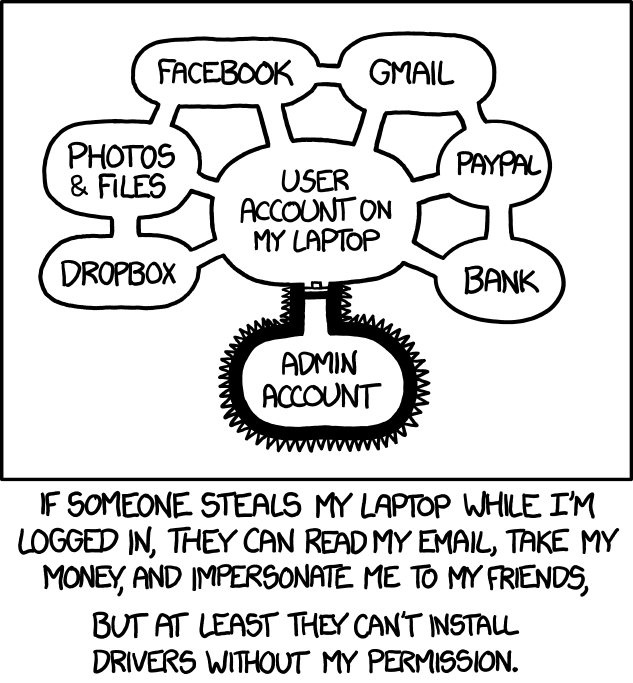I have a few Linux servers at home that I regularly remote into in order to manage, usually logged into KDE Plasma as root. Usually they just have several command line windows and a file manager open (I personally just find it more convenient to use the command line from a remote desktop instead of directly SSH-ing into the system), but if I have an issue, I’ve just been absentmindedly searching stuff up and trying to find solutions using the preinstalled Firefox instance from within the remote desktop itself, which would also be running as root.
I never even thought to install uBlock Origin on it or anything, but the servers are all configured to use a PiHole instance which blocks the vast majority of ads. However, I do also remember using the browser in my main server to figure out how to set up the PiHole instance in the first place, and that server also happens to be the most important one and is my main NAS.
I never went on any particularly shady websites, but I also don’t remember exactly which websites I’ve been on as root, though I do seem to remember seeing ads during the initial pihole setup, because it didn’t go very smoothly and I was searching up error messages trying to get it to work.
This is definitely on me, but it never crossed my mind until recently that it might be a bad idea to use a browser as root, and searching online everyone just states the general cybersecurity doctrine to never do it (which I’m now realizing I shouldn’t have) but no one seems to be discussing how risky it actually is. Shouldn’t Firefox be sandboxing every website and not allowing anything to access the base system? Between “just stop doing it” and “you have to reinstall the OS right now there’s probably already a virus on there,” how much danger do you suppose I’m in? I’m mainly worried about the security/privacy of my personal data I have stored on the servers. All my servers run Fedora KDE Spin and have Intel processors if that makes a difference?
You seriously need to stop what you’re doing. Log in with ssh only. If you need multiple terminals use multiple ssh sessions, or screen/tmux. If you need to search something do it on your desktop system.
The server should not have Firefox installed, or KDE, or anything related to desktop apps. There’s no point and nothing good can come of it.
This. Thread should have officially ended here.
Yeah there’s a bit of scope to review what op is doing here.
Why is there even a DE on a server if it’s headless. If it’s not headless why not write up some Dockerfiles and manage it from a non-root account?
Are the services running as root?
Also, is it being accessed via wireguard/ovpn? It would be unwise to run a server as root with an open port.
came to say this
Is it actually dangerous to run Firefox as root?
Yes, very. This is not specific to Firefox, but anything running as root gets access to everything. Only one thing has to go wrong for the whole system to get busted.
usually logged into KDE Plasma as root.
Please don’t do this! DEs are not tested to be run as root! Millions of lines of code are expected to not have access to anything they shouldn’t have and as such might be built to fail quietly if accessing something they shouldn’t in the first place. Same thing applies to Firefox, really.
Please don’t do this! DEs are not tested to be run as root! Millions of lines of code are expected to not have access to anything they shouldn’t have and as such might be built to fail quietly if accessing something they shouldn’t in the first place. Same thing applies to Firefox, really.
Could you elaborate on this? I’m genuinely surprised because Fedora just asks you if you want to have the option to log into root from KDE during installation, so I always just assumed that it’s intended to be used that way.
I don’t know the specifics on Fedora’s installer, but normally that question is about disabling root account, not logging into a DE.
Not sure what else to elaborate here. There’s a bunch of code that is not tested to be run as root. A whole class of exploits becomes unavailable, if you stick to an unprivileged user.
Say there’s some exploit that allows some component of KDE to be used to read a file. If it’s running under an unprivileged user - it sucks. Everything in user’s homedir becomes fair game. But if it runs as root - it’s simply game over. Everything on the system is accessible. All config, all bad config, files of all applications (databases come to mind). Everything.
Thank you.
Say there’s some exploit that allows some component of KDE to be used to read a file. If it’s running under an unprivileged user - it sucks. Everything in user’s homedir becomes fair game. But if it runs as root - it’s simply game over. Everything on the system is accessible. All config, all bad config, files of all applications (databases come to mind). Everything.
This is also something I’m thinking about: All the hard drives mounted on the server is accessible to the only regular user as that is what my other computers use to access them. I’m the only one with access to the server so everything is accessible under one user. The data on those drives is what I want to protect, so wouldn’t a vulnerability in either KDE or Firefox be just as dangerous to those files even running as the regular user?
Also, since my PC has those drives mounted through the server and accessible to the regular user that I use my PC as, wouldn’t a vulnerability in a program running as the regular user of my PC also compromise those files even if the server only hosted the files and did absolutely nothing else? Going back to the Firefox thing, if I had a sandbox breach on my PC, it would still be able to read the files on the server right? Wouldn’t that be just as bad as if I had been running Firefox as root on the server itself? Really feels like the only way to 100% keep those files safe is to never access them from an internet accessible computer, and everything else just falls short and is just as bad as the worst case scenario, though maybe I’m missing something. Am I just being paranoid about the non-root scenarios?
How does a “professional” NAS setup handle this?
You never log in as root. On every new VM/LXC I create, I delete the root password after setting it up so that my regular user can use sudo.
Run as your regular user and sudo the commands that need privileges.
Also if these are servers, run them headless. There’s no need for a GUI or a browser (use wget or curl for downloads, use your local browser for browsing)
You keep your files safe by having backups. Multiple copies. Set up the backups to gets copied to another server or other system your regular user doesn’t have access to. Ideally, you follow the 3-2-1 backup standard if the files are important. That is 3 copies, on 2 different media, and 1 offsite. There are many ways of accomplishing that and its up to you to figure out what works best.
Your frame of mind is “dangerous”. If you are browsing on your servers as root, you need to not manage servers anymore. If that sounded harsh, learn about attack surface area first and then I might let you back in the server room.
You won’t find discussions about running browsers as root because it’s not something you should need to discuss. Also, you don’t need to be browsing “shady” websites to get compromised. Get that myth out of your head.
find it more convenient to use the command line from a remote desktop instead of directly SSH-ing into the system
How is extra steps and added latency more convenient? The latency of a console via remote desktop would drive me crazy. Hell, I haven’t installed any kind of desktop environment on Linux server for over 20 years. It’s not needed and a waste of resources. Who needs file managers anyway?
Your frame of mind is “dangerous”. If you are browsing on your servers as root, you need to not manage servers anymore. If that sounded harsh, learn about attack surface area first and then I might let you back in the server room.
You sir/ma’am hit it right on the head.
The “run root on Firefox” isn’t the issue, it’s the red flag. Security is a mindset. Failure to understand the core philosophy of why we have roles and permissions means you’re untrusted. It really isn’t personal. It’s security.
https://www.mozilla.org/en-US/security/advisories/mfsa2023-56/
That’s a link to the most recent release of Firefox and the security vulnerabilities that were fixed.
You’ll notice the first one listed says, “This issue could allow an attacker to perform remote code execution and sandbox escape.”
So if you visited a site that exploited that bug, it escaped the sandbox and ran whatever code it wanted to. Since you were running as root it could do anything it wants. Your device is now the property of someone else. Potentially all your data has been stolen. You probably didn’t even notice.
Now. Realistically. You probably didn’t get exploited. Your device may not be vulnerable to that particular bug. But new bugs are found, and fixed, and created every day. Can you be sure you weren’t exploited?
Let’s look at it a different way. Think of it like driving a car with no seatbelt or airbags. As long as you don’t crash, you’re fine. The car still works fine without seatbelts and you have more freedom to move your arms around.
Let’s look at it a different way. Do you ever lock the door to your home/apartment? Heck do you even close the door? Why not leave it wide open?
At the end of the day security is about layers and the trade offs for convenience. You can run KDE as root, and you can run Firefox as root. You’ll probably be fine. It’s like driving without a seatbelt or leaving your front door wide open, but you can do it. If you do drive with a seatbelt and at least close your front door, you can probably run KDE and Firefox as a regular user.
I think there are many security issues with your setup. You really, really shouldn’t do everything as root. That is just a time bomb waiting to blow.
but no one seems to be discussing how risky it actually is.
That is because people stopped doing it ages ago.
But shouldn’t Firefox be sandboxing every website and not allowing anything to access the base system?
Security is always a matter of layers. Any given layer can fail some of the time but you want to set up your security so situations where all the layers fail together are rare.
Realistically it’s not super dangerous, and no you probably don’t have a virus just from browsing a few tech support sites, but you do eliminate your last line of defense when you run software as root. As you know, root can read/change/delete anything on your system whereas regular users are generally restricted to their own data. So if there is a security problem in the software, it’s made worse by the fact that you were running it as root.
You are right though that Firefox does still have its own protections - it’s probably one of the most hardened pieces of software on your computer exactly because it connects to the whole wide internet - and those protections are not negated by running as root. However if those protections fail, the attacker has the keys to the kingdom rather than just a sizable chunk of the kingdom.
To put that in perspective though, if there is a Firefox exploit and a hacker gets access to your regular user account, that’s already pretty bad in itself. Even if you run as a regular unprivileged user they would still have have access to things like: your personal documents, your ssh keys, your Firefox profile with your browsing history, your session cookies and your saved passwords, your e-mail, your paypal account, your banking information, …
As root, they could obviously do even more like damage like reading all users’ data, installing a keylogger or screengrabber, installing a rootkit to make themselves undetectable, but for most regular users most of the damage is already done when their own account is compromised.
So when these discussions come up, I always have to think about this XKCD comic:

They might have access to all that data once but a lot of the paths towards making that a persistent threat that doesn’t go away after the next reboot and most of the ones towards installing something even deeper in the system that might even survive a reinstall do require root.
That’s what I said yes.
An overarching principle of security is that of minimum privilege: everything (every process, every person) should have the minimum privileges it needs to do what it does, and where possible, that privilege should be explicitly granted temporarily and then dropped.
This means that any issue: a security breach or a mistake can’t access or break anything except whatever the component or person who had the issue could access or break, and that that access is minimal.
Suppose that you hit a page which exploits the https://www.hkcert.org/security-bulletin/mozilla-firefox-remote-code-execution-vulnerability_20230913 vulnerability in Firefox, or one like it, allowing remote code execution. If Firefox is running as root, the remote attacker now completely controls that machine. If you have SSH keys to other servers on there, they are all compromised. Your personal data could be encrypted for ransom. Anything that server manages, such as a TV or smart home equipment, could be manipulated arbitrarily, and possibly destroyed.
The same is true for any piece of software you use, because this is a general principle. Most distributions I believe don’t let you ssh in as root for that reason.
In short: don’t log in to anything as root; log in as a regular user and use
sudoto temporarily perform administrator actions.P.S. your description of the situation shows you don’t know the nature of vulnerabilities and security - if you’re running servers then this is something you should learn more about in short order.
I don’t want to step on your workflow too much since it somehow seems to work for you but your main issue stems from the fact that you clearly don’t work with your server as if it actually was a server.
You shouldn’t really have a desktop interface running there in the first place (let alone as root and then using it as a regular user). You should ask yourself what it actually solves for you and be open to trying different (and more standard) solutions to what you’re trying to achieve.
It’d probably consist of less clicking and using the CLI a bit more, but for stuff like file management you can still easily use
mc.If you need terminal sessions that keep scrollback and don’t stop when you disconnect you should learn to use
tmuxorscreenor something like that. But then again if you’re running actual software in there then you should probably use a service (daemon) for that.As for whether it’s a security issue, yeah it most definitely is. Just like it’s a security issue to run literally any networked application as root. Security isn’t black and white and there are trade offs to be made but most people wouldn’t consider what you’re doing a reasonable tradeoff.
I had actually moved from a fully CLI server to one with a full desktop when I upgraded from a single board computer to x86. The issue is that it’s not just a NAS, but I regularly use it to offload long operations (moving, copying, or compressing files, mostly) so I don’t need to use my PC for those. To do that I just remote into it and type in the command, then I can turn my PC off or do whatever without affecting the operation. So in a way it’s a second PC that also happens to be a server for my other machines.
I use screen occasionally, and I used to use it a lot more when it was CLI only, but I find it really unwieldy due to how it manages multiple active terminals where you have to type in the ID of each screen to go back into it, and also because it refuses to scroll even when run in a terminal emulator that supports scrolling, where it just cycles between recent commands when you move the scroll wheel.
Not trying to make excuses, just trying to explain my reasoning. I know it’s bad practice and none of these are things I’d do if I was managing an actual production server, but since it’s only accessible from my LAN I tend to be a lot more lax with it.
I’m wondering if I could benefit from some kind of virtualized setup that separates the server stuff while still letting me remote into a desktop on the same machine for doing stuff, or if I can get away with just remoting into not the root user. Though I’ve never used a hypervisor and have no idea how to so I’m not sure how well that would go, since the well-known open source ones like Xen seem really technical and really feels like something not meant to be used outside an actual data centre.
I see. In that case you should really try tmux; I didn’t vibe with screen either but I find tmux quite usable.
For the most part I just open several terminal windows/tabs on my local machine and remote with each one to the server, and I use tmux only when I explicitly need to keep something running. Since that’s usually just one thing I can use like two tmux commands and don’t need anything else.
Oh and for stuff like copying and such I’d use
rsyncinstead of primitivecpso that in case it gets interrupted I only copy what’s needed.I wouldn’t bother with virtualization and such; you’d only complicate things for yourself. Try to keep it simple but do it properly: learn some command line basics and you’ll see that in a year it’ll become second nature.
Sorry, this is very much a PEBKAC issue. This is a excerpt from my
tmuxconfig:# Start windows and panes at 1, not 0 set -g base-index 1 setw -g pane-base-index 1 # Use Alt-arrow keys without prefix key to switch panes bind -n M-Left select-pane -L bind -n M-Right select-pane -R bind -n M-Up select-pane -U bind -n M-Down select-pane -D # Shift arrow to switch windows bind -n S-Left previous-window bind -n S-Right next-window # No delay for escape key press set -sg escape-time 0 # Increase scrollback buffer size from 2000 to 50000 lines set -g history-limit 50000 # Increase tmux messages display duration from 750ms to 4s set -g display-time 4000 # Bind pane creation keys to reuse current directory bind % split-window -h -c "#{pane_current_path}" bind '"' split-window -v -c "#{pane_current_path}"I hope the comments are self explanatory.
Scrolling works with
Ctrl+b Page Up/Down. There are other shortcuts, but this is probably the most obvious.qto quit scrolling.Ctrl+b dto detach from a session.tmux ato attach. As always, many options are available to have many named sessions running simultaneously, but that is for a later time.I’d go for remoting in as not root as the first (and maybe only) step for better security.
From there, running the services in VMs would probably be the next step. Docker might be better, but I have gotten into that yet myself.
As for hypervisor, KVM has worked great for me.
KVM is awesome. It is the core of Proxmox which is my preferred way to manage VMs and LXC containers now. I used to run debian+KVM+virt-manager or cockpit but Proxmox does all the noodling setup for me and then just works.
My goodness
Yes, it is. As a user you compromise only that user as a consequence of some sandbox escape. Then there may or may not be some successful privilege elevation.
I have no clue how dangerous running Firefox as root is, but it begs the question…why would you do that?
Create a user account for managing things and create a separate user for each service and/or containers.
For managing things use tmux with ssh, if you want to manage files etc. just use ranger/lf/mc. One can also mount the file system with sshfs.
As a general best practice, you should never directly login as root on any server, and those servers should be configured to not allow remote connections as the root user. You should always log in as a non-root user and only run commands as root using sudo or similar features offered by your desktop environment. You should be wary of even having an interactive root shell open; usually I would only do so on a VM console, when first setting up a system or debugging it.
By doing this, you not only guard against other people compromising your system, but also against accidentally running commands as root that could damage your system. It’s always best to only run things with the minimum permissions they need, and then only grant them additional permissions on an as-needed basis.
you should never directly login as root on any server, and those servers should be configured to not allow remote connections as the root user. You should always log in as a non-root user and only run commands as root using sudo or similar features
That is commonly recommended but I have yet to see a good solution for sudo authentication in this case that works as well as public key only SSH logins with a passphrase encrypted key and ssh-agent on the client-side. With sudo you constantly have to use passwords anyway which is pretty much unworkable if you work on dozens of servers.
Whose letting you run dozens of servers if managing dozens of passwords is “pretty much unworkable” for you?
Of course I can store dozens of passwords but if every task that requires a single command to be run automatically on e.g. “every server with pending updates” requires entering each of those passwords that is unworkable.
FreeIPA and your password is the same on every machine: yours. (Make it good)
Service accounts should have either no sudo password or use something like Ansible with vault and keep every one of them scrambled and rotate regularly (which you can do with Ansible itself)
Yes, even if you have 2 VMs and a docker container, this is worth it.
FreeIPA and your password is the same on every machine: yours.
Any network based system like that sucks when you need to fix a system that has some severe issue (network, DNS, disk,…) which is exactly when root access is the most important.
Sounds like you’re doing things the hard way, making you believe that you are being forced into choosing between security and convenience.
Then enlighten me, what is the easy way to do tasks that do require some amount of manual oversight? Tasks that can be completely automated are easy of course but with our relatively heterogeneous servers automation a la “do it on this one test system and if it works there run it completely automatically on the 100 identical production systems” is not available to us.
Not my circus, not my monkeys. You’re doing things the hard way and now it’s somehow my responsibility to fix your mess? I’m SUPER glad I don’t work with you.
You are the one who insists that there is a better way to do things but refuse to say what that better way is.
You could implement NOPASS for the specific commands you need for a service user. Still better than just using root.
In what way would that be more secure? That would just allow anyone with access to the regular account to run those commands at any time.
You can allow only specific commands and options. See my config for example.
You can limit this to a specific user as well.
Anyone who hacks into the account can now only run those tightly defined commands and no others. Compared to root, who can run anything.
I am well aware that sudo can limit which commands you run but so can force_command in authorized_keys if you really need that functionality.
Are you asking why it’s more secure to surface a few commands without password rather than all of them…?
I am asking why it is considered to be more secure for the use case where you aren’t limiting access to a few commands because it is access meant for all kinds of admin tasks, not just one specific one (as in access for the people who need to fix unexpected problems among other things).
Realistically, there is only a trivial pure security difference between logging in directly to root vs sudo set up to allow unrestricted NOPASS access to specific users: the attacker might not know the correct username when trying to brute force. That doesn’t matter in the slightest unless you have password auth enabled with trivial passwords.
But there is a difference in the ability to audit what happened after the fact if you have any kind of service storing system logs remotely or in a tamper-proof way. If there’s more than one admin user on a service, that is very very important. Knowing where the compromise happened is absolutely essential to make things safe.
If there’s only ever going to be one administrative user (personal machine), logging in directly as root for manual administrative tasks is fine: you already know who the user is. If there’s any chance there might be more administrative users later (small but growing business), you should consider doing it right from the start.
I was aware of the login UID for auditd logging as a difference but as you say, that is only really helpful if the logs are shipped somewhere else or tampering with them is otherwise prevented for admin users. It is not quite the same but the auth.log entries sshd produces on login also contain the key fingerprint used to login these days so on a more limited scale you can at least tell who logged in when from those (or whose key but that is no different than whose account for the sudo approach).
you should consider doing it right from the start.
Do you have any advice on how to use the sudo approach without having a huge slow down in every automated process that requires
ssh user@hostcalls for manual password entry? I am aware of Ansible but I am honestly very sceptical of Python tools since they tend to break easily and often from my past experiences and I would like to avoid using additional ones for critical tasks. Plus Ansible in particular seemed to be very late with their Python 3 transition, as I recall I uninstalled it when it was one of the last tools left that did not work with Python 3.Well, my recommendations for anything semi-automated would be Ansible and Fabric/Invoke. Fabric is also a Python tool (though it’s only used on the controlling side, unlike Ansible), so if that’s a no-go, I’m afraid I don’t have much to offer.
I thought your passwordless passphrase passkey ssh connection that is superior to passwords was secure. Is it not?
It is. That is the whole point. Why would I make extra unprivileged accounts that can run any command I need to run as root at any time without a password on the system just to avoid it. That just increases the attack surface via any other vector by giving an attacker accounts to choose from to break into.
It’s about as dangerous as using IE in the old days, or Edge in administrator mode.
Just don’t do that 😁
I don’t get it anyway, if you login remotely, why don’t you just open firefox locally but on the remote servers? This makes not much sense.
But If you absolutely have to. … At least be careful with your surf-targets. A search-engine and wiki would most likely be fine. Some pron-, stream- or warez-sites? Nah. Surely not.














